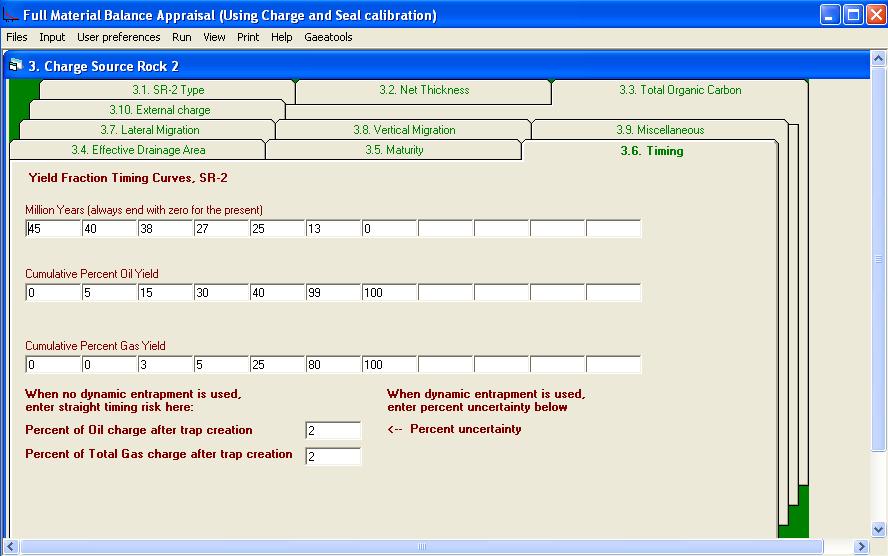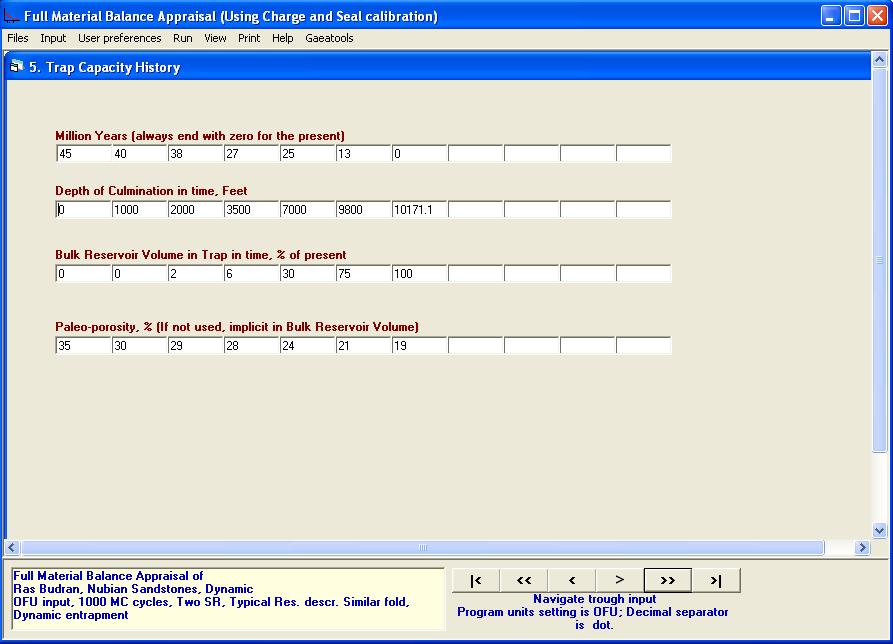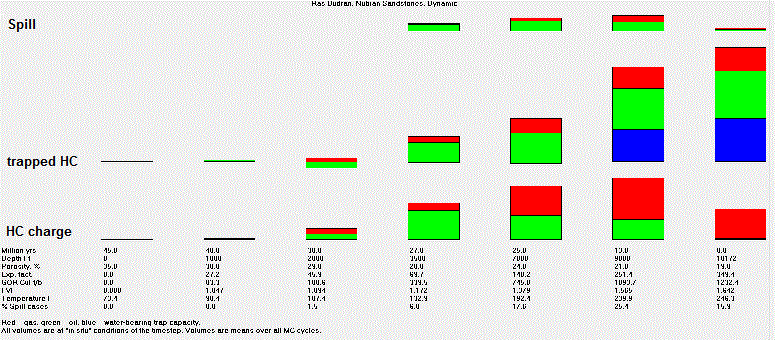Gaeapas allows under the "Full Material Balance"option" two different approaches to "timing" or synchronization of charge and trap formation.
The simple one assumes that all the charge confronted todays' trap capacity at one moment in time. If the user has doubts about the timing, he can subjectively enter a percentage of oil and gas that has been available after the trap formation. If no doubts about timing he can enter 100% for both oil and gas, meaning that there is no timing loss.
The alternative method, and more elaborate, is the "dynamic entrapment option". This takes the geological history of charge and trap into account in up to 10 time-steps through geological time. The inputs are made in the SR descriptions and in the form for trap timing.>/P>
In the case of the dynamic entrapment sub-option of FMB, up to ten timesteps can be introduced. For the entrapment the charge is calculated from the historical input to give the charge for an individual step. For each step the depth of the trap determines the PVT conditions at that time. In most cases a trap will subside with time to greater depths. But it is also possible that it becomes uplifted. In the latter case we have to allow for solution gas coming out of solution and a gas cap expanding. In the subsidence case gas goes into solution and the subsurface volume of the oil in the trap increases because of that. As will be clear this the most complicated part of the Gaeapas program.
Under the FMB option the GOR is not entirely estimated from the Vazquez-Beggs (1980) equation but the result of the FMB (calibrated) model, where the amounts of trapped solution gas and trapped oil give a GOR. The Vazquez-Beggs estimate forms an upper limit for the cases with a free gas cap. For this reason, an input GOR is irrelevant and ignored by the program.
In more detail:
The input for a dynamic entrapment appraisal (only under the FMB option) involves two input screens:
The charge history and the trap history:


There are "tstep" time inputs, including the zero time that represents the present. The input steps are referred to as "timesteps" or "time-slices". According to the need of the calculation, volumes are indicated to be at standard conditions "sc" or subsurface conditions "ss".
The simple model used here assumes that only at these discrete points in history amounts of charge are interacting with the trap capacity as available at that moment. In the case of Spill-in charge and/or additional external charge, these are included in the total charge. This total charge is then distributed over the timesteps according to the charge-timing given for the SR-1 (and SR-2). External and Spill-In charge do not have their own timing input. Because the yield history is irreversible and is given as a cumulative percentage of the total amount of charge at the present time, the differences have to be made to get individual charge amounts for the timesteps. By contrast, the pore volume (trap capacity) growth is a percentage of what it is today, so no
differences between step percentages are taken in this case.
Note that it is geologically very well possible that the trap capacity once was larger than today. This may be the result of tilting of a closure or some effect of faults that limited lateral seal.
Dynamic modeling tries to follow the interaction from the onset of trap formation or onset of charge, whatever is the earliest (oldest). Retention problems by top or seat seal are only invoked for the last time step: the present. This is because we cannot properly calibrate paleo-leakage through the seal. So what should happen is the tracking of entrapped and spilled HC in a gradually changing trap. Normally, the trap grows in time and is brought by subsidence to a greater depth. This tracking takes place for (tstep - 1) time-slices. The remaining trap capacity, trapped HC and the remaining charge after the last history step are confronted in the last step (the present time) with the retention phase modeling.
Note that by arranging the program this way, the degenerate case where no time-slices are in the input, i.e. static modeling at present time, the model becomes the same as in the last (present time) step of the dynamic modeling.
The yield history is stored in array "YLDHIST" for one or two SR. The overall charge is the combination of SR-1 and SR-2. As the two SRs may not have equal contributions to make, a weighted percentage contribution of SR-1 is calculated during the charge modeling and stored.
There are three nested loops in the entrapment routine:
Outer loop is over the the Monte Carlo cycles
Inner loop is over the tstep time intervals, where the first time point is either the zero point for the charge, or the zero point for the trap capacity, whatever is the oldest age. Keeping this logic implies that both yield history and trap history will begin with at least one zero.
Logic of the inner loop
Whether trap or charge is first, trapped HC is the minimum of the two at the timestep. The spilled HC is the charge minus the trapped, with a minimum of zero.
Interaction is at the current timestep ss conditions as have been stored previously in the PVT array.
First consider the volumes resulting from the previous step:
- Trapped oil under sc of previous phase brought to current ss (could be shallower or deeper).
This may cause some free gas to be dissolved if the trap has subsided. With a higher FVF, some oil may be lost. This means that also some solution gas may be lost. How much? Assume that this can be calculated with the GOR from the previous step. Or, in case of uplift, some gas may come out of solution. - Tapped Solution Gas sc - change based on current GOR
- Trapped Free Gas sc revised because of changes in solution gas volume.
- Trapped Free Gas sc brought to current ss.
- Pore Volume at current time step.
Calculate remaining pore volume:
Pore Volume = Pore Volume minus ss space occupied by the trapped oil and free gas If remaining pore volume < 0 (i.e. too much expansion in an already well-filled trap) then the charge order becomes "first fit the gas, then fit any of the trapped oil".
In other words: first bleed off oil, then gas, save it in the spill file.
At this point the trap has been brought to the present depth of the timestep.
Now invoke the current charge:
- TGASsc is current the charge of total gas at standard conditions, scaled down with the yield percentage of the timestep found in YLDHIST.
- Solution gas sc is OIL sc times the GOR)
- Free gas charge after solution gas is (Total Gas Charge - Solution gas charge)
- Free gas charge at ss conditions, is Free Gas sc divided by EFACT (= expansion factor).
- OIL ss Charge is inflated by multiplying OIL vsc with FVF to ss conditions.
- Pore Volume is adjusted to the timestep.
- Trapped gas is the free gas trapped: MIN(Free gas, Pore Volume).
- Trapped gas sc: Trapped Gas ss times EFACT.
- Spilled free gas ss: (Free Gas ss - Trapped Gas ss)
- Spilled free gas sc is Spilled free gas ss times EFACT.
- Remaining Pore Volume, remaining trap space for oil is MAX((Pore Volume - Trapped Free gas ss),0)
- Trapped oil ss is MIN(OIL ss,Remaining pore volume)
- Trapped Oil sc is Trapped Oil ss divided by FVF (Formation Volume Factor).
- Spilled oil: (OIL ss - Trapped OIL ss)
- Spilled oil sc is Spilled Oil ss/FVF
- Total spilled gas sc is spilled free gas + the solution gas in the spilled oil.
- Total GAS charge sc is now reduced to the remaining TGAS charge after this timestep, i.e. reduced by the trapped charge, the solution gas in the trapped charge and the spill.
- OILsc is now reduced to the remaining oil charge after this timestep: OIL charge sc = OIL charge sc - Trapped oil sc - Spilled OIL sc
- Cumulate spills in the overall spill vectors, SPTGAST, SPOILT.
The charge algorithm contains the third loop: an iterative loop zero-ing in on the volumes trapped.
End of inner loop
Write results to file
End of outer loop.
Output files
There are two output files that transmit dynamic data from the GCalcul.exe to the gaea.exe for display. The first is DynGraph.txt stored in the Temp folder. This provides a table with 10 items in a row and 11 rows. The rows are labeled with the million years age that belong to the time step. The volumes are at standard conditions.The items are:
- Million years
- Depth
- Trapcap
- Porosity
- Total gas charge
- Oil charge
- Total gas spill
- Oil spill
- Trapped free gas
- Trapped oil
The second file DynGraphss.txt gives the same data in (paleo)subsurface conditions .
The items are
- Million years
- Depth
- Trapcap
- Porosity
- Total gas charge
- Oil charge
- Total gas spill
- Oil spill
- Trapped free gas
- Trapped oil
- Trapped Solution gas.
- Expansion factor
- Gas/Oil ratio (GOR)
- Formation Volume Factor (FVF)
This data is shown in a set of bar graphs:
